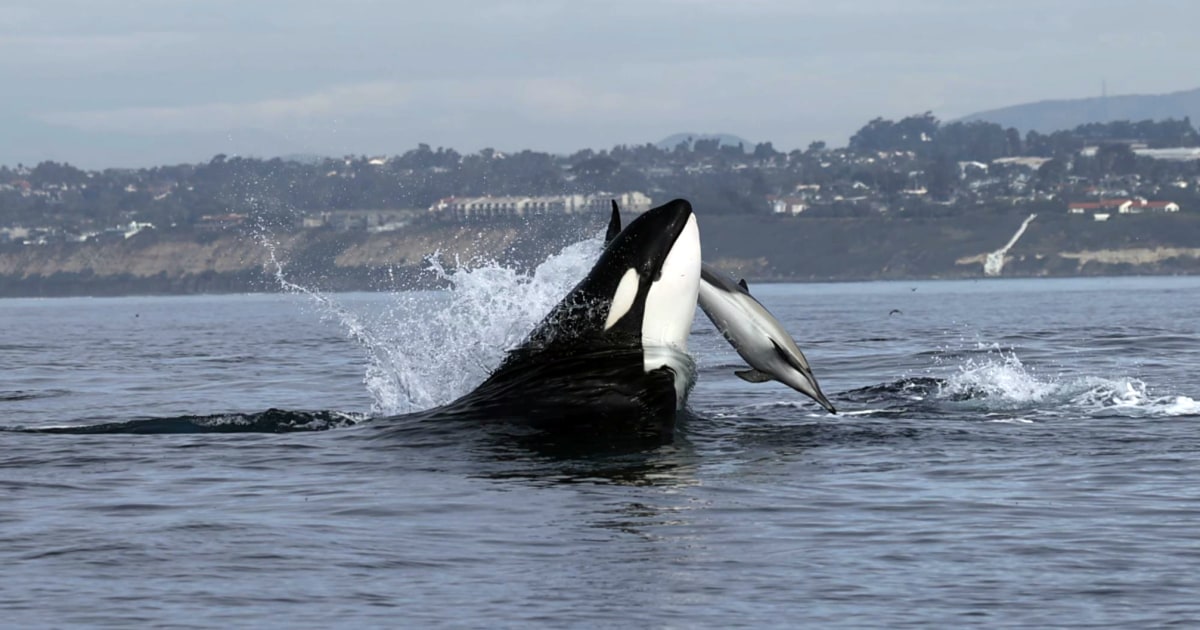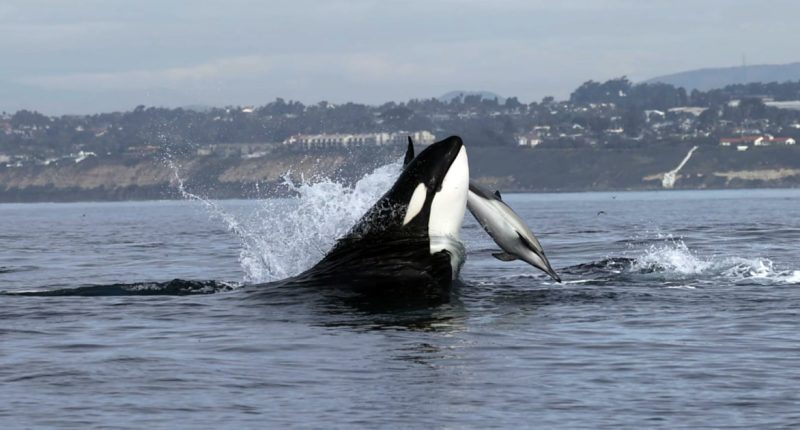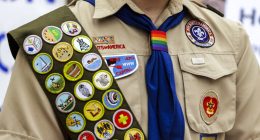
In a rare video captured by a whale watching expedition off the coast of San Diego this week, a killer whale teaches its baby how to hunt by headbutting a dolphin, causing it to flip several times in the air.
“The orcas catch the dolphin, but let it go after it’s subdued because it’s not as fast anymore, and they bring the baby orca over to try and catch it itself,” said Domenic Biagini, the wildlife filmmaker that captured the footage. “To see that level of communication and understanding — it was like watching a family.”
Biagini founded Gone Whale Watching, one of several companies that sighted the pod of six orcas off the coast of San Diego on Monday. He said the hunt took around 30 minutes, which is much longer than the average orca hunt, because they were teaching their young.
As one of the ocean’s apex predators, orcas are known to incorporate their large size and speed into their hunting strategies, said Alisa Schulman-Janiger, a marine biologist and co-founder of the California Killer Whale Project. It is common for them to slow down prey to demonstrate hunting to their young.
“Killer whales can easily travel 25 miles an hour,” said Schulman-Janiger. “To punch a hole in the side of a dolphin and hit it so hard that it’s jumping so high out of the water — the force is tremendous.”
The orca in the footage is so young that its eye patch is yellow instead of white, a coloring which eventually fades away as the orca gets older, said Schulman-Janiger.
Where did the whales come from?
The whales in Biagini’s footage are Eastern Tropical Pacific Orcas, which typically reside in the waters of Mexico and Central America, according to Schulman-Janiger. It is rare to see them in the comparably warm, calm waters of Southern California.
The abundant population of dolphins in the area is likely less accustomed to killer whales hunting them, according to Schulman-Janiger.
“We try to explain to our guests that while what the whales do to the dolphins can get pretty gruesome at times, this is normal and healthy,” said Biagini. “It means our ecosystem is functioning the way it is supposed to.”
Nonetheless, Biagini says he often cuts out parts of his footage that get too bloody to avoid over-sensationalizing the violence of the hunt.
“Think of us on a Thanksgiving feast”: Orcas celebrating the hunt
After the hunt on Monday, Biagini said the orcas started to approach boats and poke their heads out of the water to see what is going on — a behavior known as spy hopping.
More social behavior is common in orcas after a successful hunt, because they celebrate and often zig zag back and forth in the water, said Biagini.
“Think of us on a Thanksgiving feast after we eat, when we’re in a good mood and laughing. That’s what it looks like with the killer whales after they make a hunt,” said Biagini.
Since 2020, interactions between orcas and human vessels have been increasing, although no human deaths or injuries have been reported. That prompted the phrase “orca wars” to start trending on social media, which describes a fictional battle between humans and killer whales.
The dangers of whale watching crowds
During the orca sighting on Monday, Biagini said there were between 12 to 15 boats in the water around the pod all trying to catch the rare sighting.
Too many boats with inexperienced operators around a pod of orcas runs the risk of impeding their hunting behavior or potentially hitting them, said Schulman-Janiger.
Marine Mammal Protection Guidelines released by the National Oceanic and Atmospheric Administration (NOAA) specify that boats should try to stay at least 100 yards — or the length of a football field — away from orcas.
At one point, Biagini said he was so worried about boxing the orcas in with the overwhelming amount of boats that he got on the radio to warn others to space out.
In one video he captured, a man driving a boat by himself abandons the wheel to lean over the deck and film a video.
Biagini said it is often frustrating to watch people get too close to the orcas to film a social media video, knowing that many viewers don’t stop to question how it was captured.
“As much as I want to get the shot, the most important part of it is getting them in the most ethical way. We focus on trying to be the stewards for the animals,” said Biagini.
Source: | This article originally belongs to Nbcnews.com









